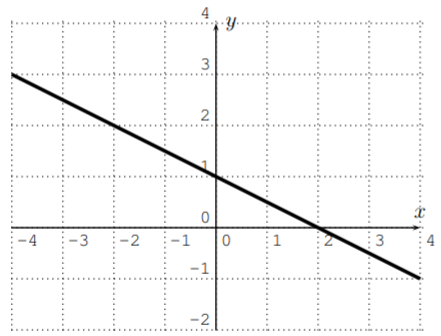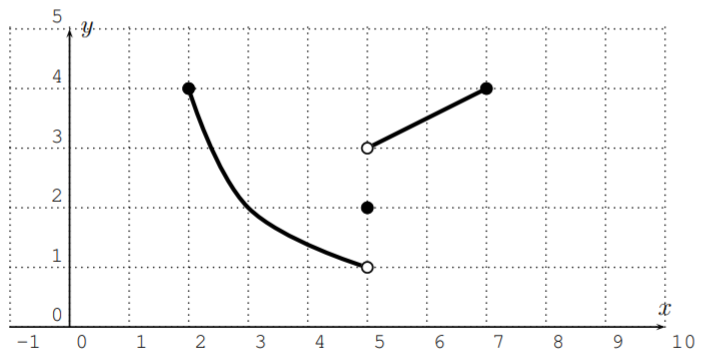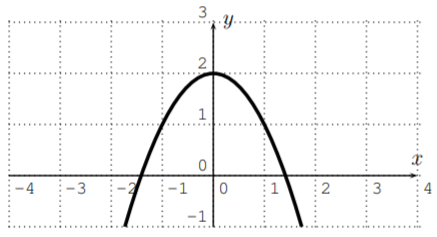27.1: Revisión de funciones y gráficas
- Page ID
- 117673
Encuentra todas las soluciones de la ecuación:\(\big| 3x-9\big| =6\)
- Contestar
-
\(x = 1\)o\(x = 5\)
Encuentra la ecuación de la línea que se muestra a continuación.

- Contestar
-
\(y=-\dfrac{1}{2} x+1\)
Encuentra la solución de la ecuación:\(x^3-3x^2+2x-2=0\) Aproxima tu respuesta a la centésima más cercana.
- Contestar
-
\(x \approx 2.52\)
Vamos\(f(x)=x^2-2x+5\). Simplifica el cociente de diferencia tanto\(\dfrac{f(x+h)-f(x)}{h}\) como sea posible.
- Contestar
-
\(2 x-2+2 h\)
Considera la siguiente gráfica de una función\(f\).

Encontrar: dominio de\(f\), rango de\(f\),\(f(3)\),\(f(5)\),\(f(7)\),\(f(9)\).
- Contestar
-
dominio\(D=[2,7]\), el rango no\(R=(1,4], f(3)=2, f(5)=2, f(7)=4, f(9) \) está definido
Encuentra la fórmula de la gráfica que se muestra a continuación.

- Contestar
-
\(f(x)=-x^{2}+2\)
Dejar\(f(x)=5x+4\) y\(g(x)=x^2+8x+7\). Encontrar el cociente\(\left(\dfrac f g\right)(x)\) y exponer su dominio.
- Contestar
-
\(\left(\dfrac{f}{g}\right)(x)=\dfrac{5 x+4}{x^{2}+8 x+7}=\dfrac{5 x+4}{(x+7)(x+1)}\)tiene dominio\(D=\mathbb{R}-\{-7,-1\}\)
Dejar\(f(x)=x^2+\sqrt{x-3}\) y\(g(x)=2x-3\). Encontrar la composición\((f\circ g)(x)\) y exponer su dominio.
- Contestar
-
\((f \circ g)(x)=4 x^{2}-12 x+9+\sqrt{2 x-6}\)tiene dominio\(D=[3, \infty)\)
Considera las asignaciones para\(f\) y\(g\) dadas por la siguiente tabla.
\ [\ begin {array} {|c||c|c|c|c|c|}
\ hline x & 2 & 3 & 4 & 5 & 6\
\ hline f (x) & 5 & 0 & 2 & 4 & 2\
\ hline g (x) & 6 & 2 & 3 & 4 & 1\
\ hline
\ end {array}\ nonumber\]
¿Es\(f\) una función? ¿Es\(g\) una función? Escribir la tarea compuesta para\((f\circ g)(x)\) como una tabla.
- Contestar
-
\(f\)y\(g\) son ambas funciones, y la composición viene dada por la tabla:
\ (\ begin {array} {|c||c|c|c|c|c|}
\ hline x & 2 & 3 & 4 & 5 & 6\
\ hline\ hline\ hline f (x) & 5 & 0 & 2 & 4 & 2
\\ hline g (x) & 6 & 2 & 3 & 4 & 1\
\ hline (f\ circ g) (x) & 2 y 5 & 0 & 2 &\ text {undef.}\\
\ hline
\ end {array}\)
Encuentra la inversa de la función\(f(x)=\dfrac{1}{2x+5}\).
- Contestar
-
\(f^{-1}(x)=\dfrac{1}{2 x}-\dfrac{5}{2}\)


